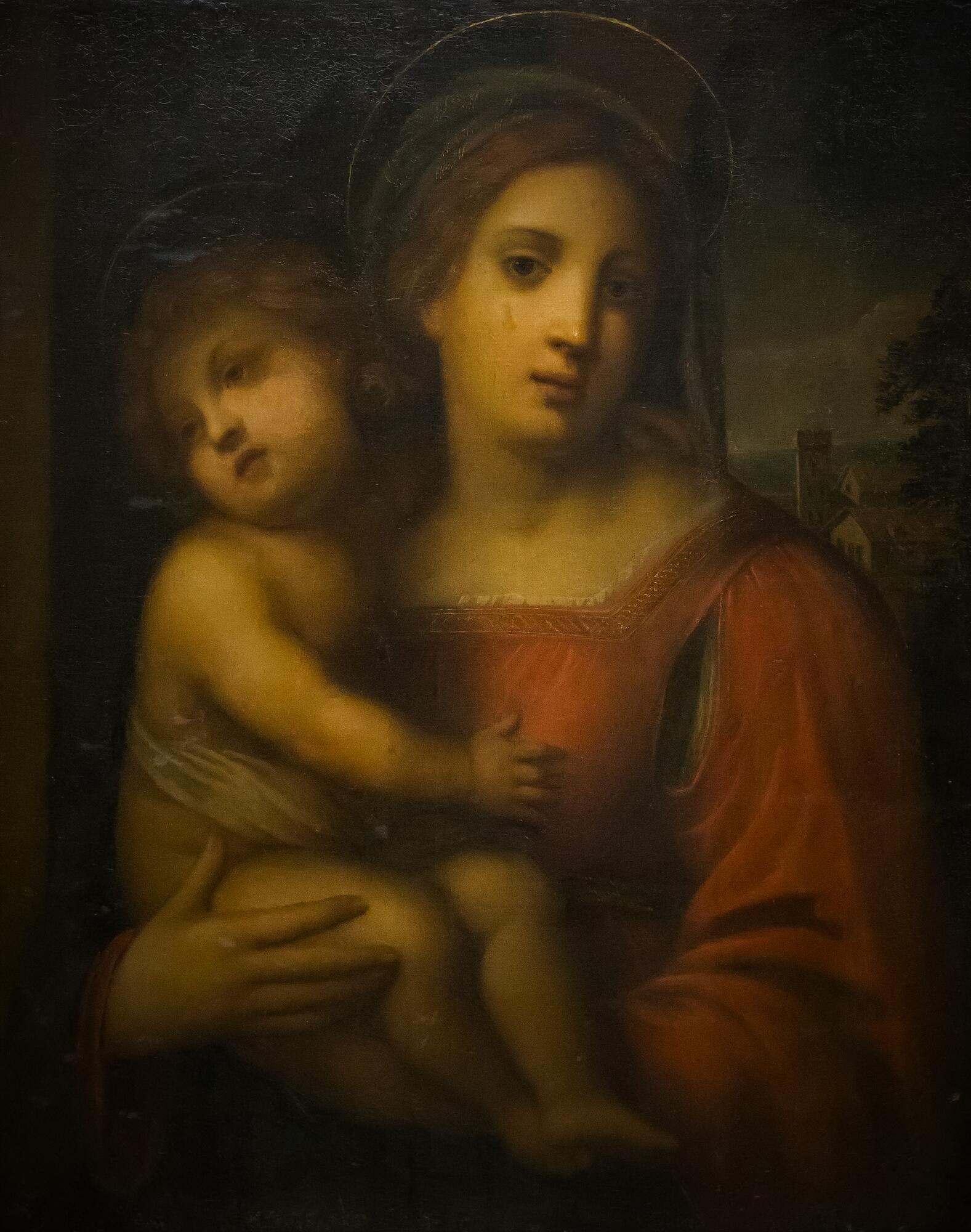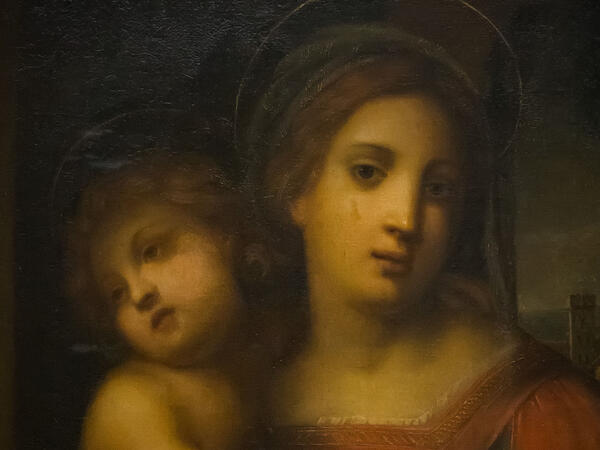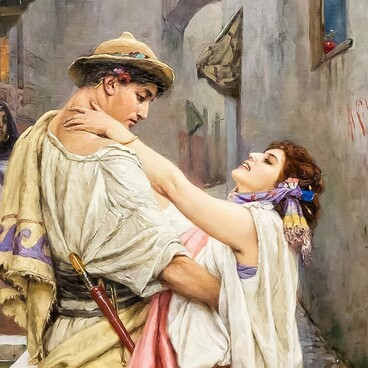‘Madonna and the Child’ was painted by Domenico Puligo in the 16th century. Madonna holds the Child gently with both her arms while looking at the viewers with admiration and quiet serenity in her eyes.
It is of interest that the artist depicted the Mother of God as a real woman, whose dress and hairstyle correspond to the fashion of his time. Nevertheless, there is still something elusive about the image of Mary that emphasizes her spiritual purity. It seems that, with this image of the Beautiful Virgin and Saint Mary of Graces, the artist tried to depict an ideal person.
The artist’s choice of technique contributed a lot to creating the mood of the painting. Domenico Puligo lived at the same time as Leonardo da Vinci, so he already knew about the latter’s sfumato technique. The Italian word ‘sfumato’, literally meaning ‘gone up in smoke’, can be translated as ‘blurred’. It is a painting technique that is used for softening the outlines of objects. To achieve a more believable image, the contours and contrasts are painted as if in a light haze.
The fact is that, when developing the sfumato technique, da Vinci took into account the peculiarities of human vision, which always focuses only on one part of the object thus making the rest slightly blurred. This technique is also used to reflect the air that envelopes objects. The most famous painting displaying this technique is the ‘Mona Lisa’ by Leonardo da Vinci. It is exactly because of the blurry corners of the eyes and lips that Mona Lisa looks extraordinary realistic.
Domenico Puligo used sfumato to highlight the center of the composition. The figures of the Mother and Child seem to be surrounded by a light haze, which subdues the bright colors of the clothes and makes the shadows and the dark background lighter. The blurred contours reflect the warmth and tenderness of the Child’s skin, as well as the fabric texture of Mary’s dress.
Domenico Puligo was an Italian Renaissance painter. His real name was Domenico di Bartolomeo Ubaldini, however he is better known by his pseudonym. The artist worked in Florence in the first half of the 16th century. The Florentine school of painting was distinguished by having its own principles: its artists elaborated the composition of the picture, using the laws of linear perspective. They also strove to realistically depict the anatomy of a human figure and preferred simple compositions with no excessive detailing. They paid great attention to the drawing stage trying to bring the arrangement of the painting to perfection. At the same time, their canvases are filled with the atmosphere of a quiet, lyrical contemplation.
‘Madonna and the Child’ was an heirloom of the Likhachov family. To avoid the possible damage to the painting, Andrey Likhachov — the head of the family — made the crucial decision to arrange a complex procedure of transferring the painting from its wooden board to a canvas. In 1891, after the connoisseur’s death, his collection was donated to the city. However, Likhachov’s widow kept ‘Madonna and the Child’ in the family for a long time after that — she did not want to part with it. Only in 1919, after almost 20 years, Raisa Likhachova agreed to donate the painting to the city museum.
It is of interest that the artist depicted the Mother of God as a real woman, whose dress and hairstyle correspond to the fashion of his time. Nevertheless, there is still something elusive about the image of Mary that emphasizes her spiritual purity. It seems that, with this image of the Beautiful Virgin and Saint Mary of Graces, the artist tried to depict an ideal person.
The artist’s choice of technique contributed a lot to creating the mood of the painting. Domenico Puligo lived at the same time as Leonardo da Vinci, so he already knew about the latter’s sfumato technique. The Italian word ‘sfumato’, literally meaning ‘gone up in smoke’, can be translated as ‘blurred’. It is a painting technique that is used for softening the outlines of objects. To achieve a more believable image, the contours and contrasts are painted as if in a light haze.
The fact is that, when developing the sfumato technique, da Vinci took into account the peculiarities of human vision, which always focuses only on one part of the object thus making the rest slightly blurred. This technique is also used to reflect the air that envelopes objects. The most famous painting displaying this technique is the ‘Mona Lisa’ by Leonardo da Vinci. It is exactly because of the blurry corners of the eyes and lips that Mona Lisa looks extraordinary realistic.
Domenico Puligo used sfumato to highlight the center of the composition. The figures of the Mother and Child seem to be surrounded by a light haze, which subdues the bright colors of the clothes and makes the shadows and the dark background lighter. The blurred contours reflect the warmth and tenderness of the Child’s skin, as well as the fabric texture of Mary’s dress.
Domenico Puligo was an Italian Renaissance painter. His real name was Domenico di Bartolomeo Ubaldini, however he is better known by his pseudonym. The artist worked in Florence in the first half of the 16th century. The Florentine school of painting was distinguished by having its own principles: its artists elaborated the composition of the picture, using the laws of linear perspective. They also strove to realistically depict the anatomy of a human figure and preferred simple compositions with no excessive detailing. They paid great attention to the drawing stage trying to bring the arrangement of the painting to perfection. At the same time, their canvases are filled with the atmosphere of a quiet, lyrical contemplation.
‘Madonna and the Child’ was an heirloom of the Likhachov family. To avoid the possible damage to the painting, Andrey Likhachov — the head of the family — made the crucial decision to arrange a complex procedure of transferring the painting from its wooden board to a canvas. In 1891, after the connoisseur’s death, his collection was donated to the city. However, Likhachov’s widow kept ‘Madonna and the Child’ in the family for a long time after that — she did not want to part with it. Only in 1919, after almost 20 years, Raisa Likhachova agreed to donate the painting to the city museum.



